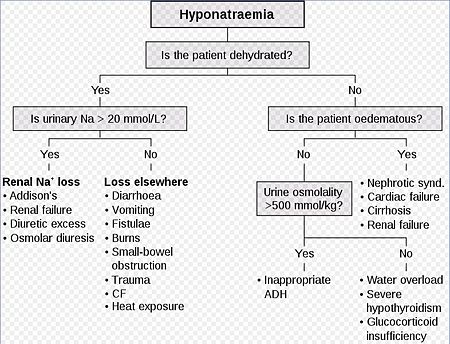Hyponatraemia: Difference between revisions
Jump to navigation
Jump to search
Kingrajinix (talk | contribs) |
Kingrajinix (talk | contribs) |
||
| Line 6: | Line 6: | ||
===Pathophysiology=== | ===Pathophysiology=== | ||
Basically, this picture explains it all | Basically, this picture explains it all<br> | ||
[[image:lowsodium.jpg|450px]] | [[image:lowsodium.jpg|450px]] | ||
====Hypovolaemic==== | ====Hypovolaemic==== | ||
Revision as of 11:49, 11 January 2010
Definition
Serum sodium<135mmol/L (<120mmol/L is severe).
Epidemiology
It is the most common electrolyte abnormality. 4.4% of postoperative patient have it. Almost 100% will have had an operation.
Pathophysiology
Basically, this picture explains it all

Hypovolaemic
- Kidney problems - Addison's, renal failure, acute tubular necrosis, chronic pyelonephritis, diuretics and others
- Non-renal - diarrhoea and/or vomiting, burns, pancreatitis, trauma, fistula, small bowel obstruction, endurace sport event, heat exposure
Not hypovolaemic
- Oedmatous - nephrotic syndrome, heart failure, cirrhosis, renal failure
- Normovolaemic - SIADH, water overload, severe hypothyroidism, glucocorticoid deficiency
Clinical Features
- Neuro - headache, decreased level of consciouness, cognitive impairment, personality change seizure, brain stem herniation (fixed unilateral dilated pupil, decorticate or decerebrate postuiring, respiratory arrest)
- GI - nausea, vomiting
- General - lethargy, muscle cramps and weakness
- If hypovolaemia - dry mucous membranes, tachycardia, reduced skin turgor
- If hypervolaemia - crackles, third heart sound, raised JVP, peripheral oedema, ascites
Investigations
Dehydration
- U+Es are useful for sodium (obviously) but also assessing dehydration (urea and creatinine).
Further diagnosis
Firstly determine their hydration status. Then the most important things are:
- Urinary sodium
- Urine osmolality
The reason being the help to determine which of the causes is most likely. In hypovolaemia:
- Urinary sodium >20mmol/L - renal cause
- Urinary sodium <20mmol/L - non-renal cause
In normovolaemia:
- Urine osmolality >100mOsmol/kg - SIADH
Otherwise, it must be something else. See pathophysiology.
Management
- Hypovolaemia - isotonic saline replacement
- Normovolaemia - fluid restrict to 500ml/24h.
- Hypervolaemia - furosemide, ACE inhibitors, fluid restrict.
